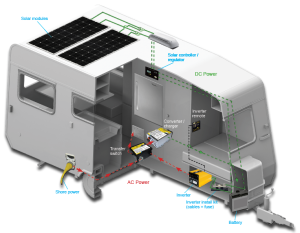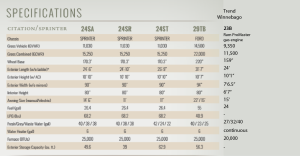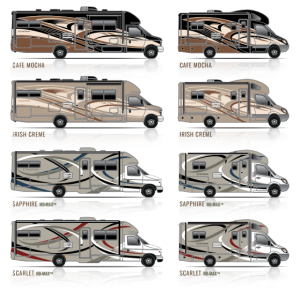Solar power is a viable expense for RVs. Go Power! offers a sizing calculator to see which solar kit fits best for the consumer [1]. Also it offers a “solar map” that shows the United States by month and how much solar radiation a region of the country receives [2].
The Wynns are using solar power for their RV and have a helpful video explaining their system [3]. They bought a Go Power! solar kit for $4000 off of Amazon.com which comes with the following:
– 160 watt solar charging kit, 2 x 160 watt expansion kit
-3000 watt pure sine wave inverter for AC power
-30 amp pulse width modulated digital solar controller
-75 amp smart battery charger
-DC inverter install kit and Inverter Remote
On sunny days, they bring in over 25 amps, but even during cloudy days they bring in around 10 amps. Wynns recommend adding solar power to your RV if you normally are wild camping or boondocking.
Through further exploration of the Wynn’s website, over the years they have upgraded their solar power systems and most recently have been using flexible solar panels. As of two days ago, they posted their review of using solar power after one year [4]. With their flexible panels they have found some of the negative qualities about them:
– cupping of the material (concavity)
-surface scratches from having to clean it
-gouges from tree branches when driving through forests
-the panels are glued and easier installation but then they are unable to tilt them up to receive maximum sunlight
Though they have not noticed any less quality or less amps that are brought in. The flexible ones are more light-weight and have a warranty of 10 years but then the tempered glass solar panels have a 30 year warranty. Yet, it should still be considered that in 10 years from now the technology of solar panels will have advanced so keeping the same solar panel for 10 years is ideal before purchasing a more efficient one.
This is the Wynn’s overview of solar power usage from 2011 [5].
| Basic | Medium | Heavy |
| Power lights, run a fan, keep house batteries charged | Power lights, run a fan, charge cell phones, laptop and watch 2 hours of TV a day | Power lights, run a fan, charge cell phone, laptop, watch 2 hours of TV a day, use electric kettle, electric blender, run the microwave for 5 minutes |
| 12 volt Basic System | 12 volt medium system | 12 volt Heavy Duty system |
| 55 watt module | 2 – 140 watt modules | 6 – 140 watt modules |
| Charge control | Charge control | Charge control |
| 25’ module cables | 25’ module cables | 25’ module cables |
| 10’ battery cables | 10’ battery cables | 10’ battery cables |
| Fuses, fuse holders | Fuses, fuse holders | Fuses, fuse holders |
| Average use per day: 220 watt hours Cost $478 | 1120 watt hours Cost $1,175 | 3360 watt hours Cost $12,708 |
| 2000 watt pure sine inverter/ charger, AC hook up wire, remote inverter controller | ||
| *battery bank not included | *recommended 200 AH battery bank | *recommended 600 AH battery bank |
Most websites speaking about RVs using solar panels refer to Go Power! as the company of choice. DoItYourselfRV.com says how to expect to pay $200 for every 100 watts of solar power.
Sources:
[1] https://tools.carmanah.com/src.web/GoPowerCalculator.htm?state=RvDiv
[2] http://rredc.nrel.gov/solar/old_data/nsrdb/1961-1990/redbook/atlas/Table.html
[3] http://www.gonewiththewynns.com/extreme-rv-solar
[4] http://www.gonewiththewynns.com/flexible-rv-solar-issues-review
[5] http://www.gonewiththewynns.com/solar-power
[6] http://www.doityourselfrv.com/rv-solar-panel-kits-systems/










